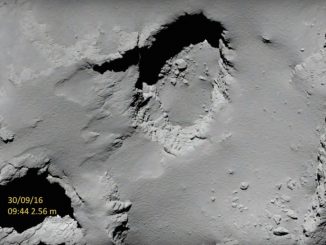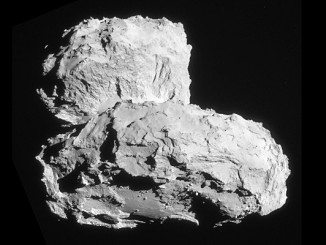
comet 67P/Churyumov–Gerasimenko




Philae found! Rosetta’s lander wedged in cometary crevice
Less than a month before the end of the mission, Rosetta’s high-resolution camera has revealed the Philae lander wedged into a dark crack on Comet 67P/Churyumov–Gerasimenko. The images were taken on 2 September by the OSIRIS narrow-angle camera as the orbiter came within 2.7 kilometres of the comet’s surface.


Rosetta’s Comet 67P contains ingredients for life
The possibility that water and organic molecules were brought to the early Earth through cometary impacts has long been the subject of important debate. Now, ingredients crucial for the origin of life on Earth, including the simple amino acid glycine and phosphorus — key components of DNA and cell membranes — have been discovered at Comet 67P/Churyumov-Gerasimenko.

No. 9 Rosetta rides with its comet
While 2014 was the year the Rosetta spacecraft celebrated making it into orbit around a comet, 2015 was the year it got down to some serious hard work. Its comet, with the tongue-twisting name 67P/Churyumov–Gerasimenko, made its closest approach (186 million kilometres) to the Sun, a period known as perihelion when the comet would be expected to be at its most active. Rosetta was there to witness this.

Surprising discovery of molecular oxygen on comet 67P
ESA’s Rosetta spacecraft has made the first in situ detection of oxygen molecules outgassing from Comet 67P/Churyumov-Gerasimenko, a surprising observation that suggests they were incorporated into the comet during its formation. This may have implications for our understanding of the chemistry involved in the formation of the solar system some 4.6 billion years ago.

How Rosetta’s comet got its shape
The origin of of Comet 67P/Churyumov-Gerasimenko’s double-lobed form has been a key question since Rosetta first revealed its surprising shape in July 2014. By studying the layers of material seen all over the nucleus, scientists have shown that the shape arose from a low-speed collision between two fully fledged, separately formed comets.

